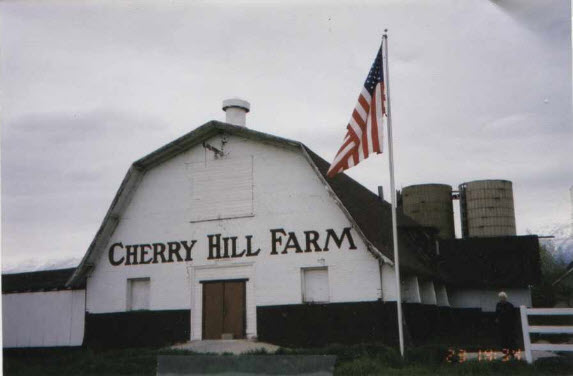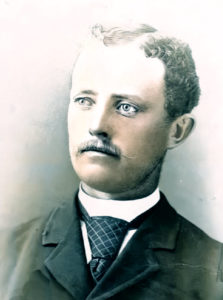William Joseph Taylor
William Joseph Taylor Jr. was born on 23 Nov 1859 in Provo, Utah, Utah, United States. He died on 30 Dec 1936 in Provo, Utah, Utah, United States. He was buried on 3 Jan 1937 in Provo City Cemetery, Provo, Utah, Utah, United States. William married Abby Jane SCOTT on 3 Aug 1882 in Salt Lake City, Salt Lake, Utah, United States.
The following is an extract from “Joe and Abby” compilation:
These are characteristics of the life of William Joseph Taylor, fifth child and eldest son of William Joseph And Mary Bowring Taylor, pioneers who come to The United States from England in February 1853. William was born November 23rd,1859, at 168 N 600 W, Provo, Utah.
He was baptized in the year 1868 by George Thatcher in the main ditch stream near the pace corner which is now on the state highway. The following year, on May, 18th 1869, his father died at the age of 37 years leaving his widow with a small family of eight children, the oldest boy, William Joseph, being 10 years of age. The other children were Eliza, Ellen, Marta, Winnifred, Walter, Lydia and an infant daughter who died as a baby.
All of William’s early teaching was done by various individuals in their home. He attended the Brigham Young Academy located on the what is now center street and 3rd West at the site of the farmers and merchants bank building which late burned. .
William was ordained a Deacon in 1871. As a boy, he worked during the summer months with the Holiday boys herding cows, raking hay and grain with hand rakes and riding a horse for cultivating crops and other farm duties . Grandmother Taylor tells of taking her young children and going into the green fields to glean in what was then called the Fort fields.
At the age of 15 in 1874, William Joseph went to work for the Provo woolen Mills which had just been completed, and here he learned to weave. For six months he ran a loom, receiving from $3 to $5 per week. Later he worked in the finishing Department. He received one-half woolen mill script and one-half East and West merchandise pay.
In the fall of the year 1878 the Denver and Rio Grande western railroad was built into Provo and in the spring of 1879 he quit the woolen Mills and went with the construction crews to build the railroad on into Salt Lake City. Who he worked for four years.
On August 3 1882, he was married to Abby Jane Scott, daughter of Bishop Andrew H. and. Sarah Anne Humphrey Roe Scott in the endowment house by Daniel H. Wells
He quit the railroad in the spring of 1883 and during the summer he worked for Walter Scott for which he received a team of scrub horses brought out of the stray pound for $15 and one fourth-hand pair of harnesses purchased from James Boen for $20.00 and 50 bushels of corn and 50 bushels of carrots.
With these meager implements, he and his brother, Walter, cultivated the land left by their fathers, it was situated in what was known as the Fort Field, it being in the vicinity of the first fort erected by the pioneers upon their arrival in the Valley valley and was used as a refuge from hostile Indians
In the year 1886 he went with his family to the and am charcoal kiln in the Spanish fork Canyon , where he, with Frank Andrew and Scott Howard Connor had had a contract to burn charcoal which was sent to the Murray and Sandy smelters . It was there that a Sunday school was organized in which he was asked to be Superintendent. His experiences as assistant Sunday school Superintendent too in the Provo second Ward helped him to see carry on the work.
Two years were spent at the charcoal kiln where on August 15th 1887 he received a letter from what was then called BOX, a request from president Wilford Woodruff to be ready on October the 6th at conference to go out into the mission in the southern states. With the family of three small children, a widowed mother, and younger sister. Lydia to help raise and support, he wrote that it would be impossible to get ready at such a short notice. He received message from President Woodruff to be ready at the April conference in 1888. At that time, missionaries paid all their own expresses save railroad fare home. He confirms the fact that the Lord did help to open the way and provide means whereby he was able to accumulate enough means to go and leave his family provided for.
On April 28th, 1888, he bid farewell to family and friends and departed for the southern States and was assigned to the Alabama conference where for the last part of the mission he acted as conference president.
While away his, his family passed through many trying circumstances. Typhoid fever attack the oldest son, William W , who for weeks lingered between life and death. His recovery was a testimony of the healing power made manifest at the hands of the Bishop James M. Loveless. Another son, Scott, contracted chills and fever, a disease worry month there were client friends and neighbors to help the mother care for this him. Mother often said that she laid his recovery on the tender care of Sorenson, a dear friend of the family who nursed the sick child for many weeks.
The first summer after father’s return, he worked for William Probart building a street railroad to Utah Lake. It ran down center St to Utah Lake but proved to be an expensive experiment.
The 1891 one 1892 he worked as assistant mechanic at the Provo woolen Mills. He served three years as Provo city watermaster from 1892 to 1895. He also served as Fire Chief from 1896 to 1899, an as city sextant from 1900 to 1903.
 With seven sons growing up, the thought of a farm where they might be a little independent was upper-most in his mind, so negotiations were made to purchase the Amos D Holdaway ranch in vineyard. The family moved there in 1904. No paved roads made traveling inconvenient, and during the wet season the vicinity was almost inaccessible on account of deep mud. The family lived at that location for one year, and then purchased the J . J. Dilatush, or George C Scott farm in Lakeview. This tract comprised a goodly number of acres. Father later acquired the tracks of Frank Hopkins on the North and Hiram Scott on the South. He and his boys established the Cherry Hill dairy in the year 1906. The milk carts from the dairy were familiar sights to the many people in Provo who depended on them for their milk. Most of the boys have valid tales to tell of their experiences driving in the milk trucks.
With seven sons growing up, the thought of a farm where they might be a little independent was upper-most in his mind, so negotiations were made to purchase the Amos D Holdaway ranch in vineyard. The family moved there in 1904. No paved roads made traveling inconvenient, and during the wet season the vicinity was almost inaccessible on account of deep mud. The family lived at that location for one year, and then purchased the J . J. Dilatush, or George C Scott farm in Lakeview. This tract comprised a goodly number of acres. Father later acquired the tracks of Frank Hopkins on the North and Hiram Scott on the South. He and his boys established the Cherry Hill dairy in the year 1906. The milk carts from the dairy were familiar sights to the many people in Provo who depended on them for their milk. Most of the boys have valid tales to tell of their experiences driving in the milk trucks.
While in Lakevew, Grandfather was president of the Lake bottom canal company. He maintained three sons on a mission and Frank was sent to serve his country in World War One.
On December 27th, 1937 he became suddenly ill and before help could be obtained he passed away. He left eleven children, 53 grandchildren, eleven sons and daughter in laws and one great grandchild.
